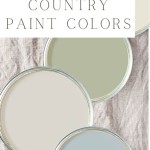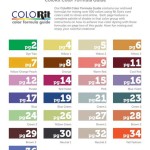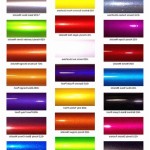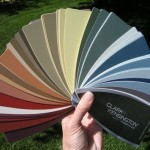Best Color to Paint a Wood Fence: A Comprehensive Guide
Selecting the optimal color for a wood fence is a decision that goes beyond mere aesthetics. It involves considering functionality, longevity, and the overall integration of the fence with the surrounding environment. A well-chosen fence color can enhance curb appeal, provide a sense of privacy, and even influence the lifespan of the wood itself. This article will explore various factors contributing to the selection of an appropriate color for a wood fence, providing insights into how different hues interact with sunlight, weather patterns, and the overall landscape.
The choice of color should be a deliberate process, considering both the immediate aesthetic goals and the long-term maintenance requirements. Darker colors, for example, tend to absorb more heat, potentially leading to increased expansion and contraction of the wood, which can contribute to warping or cracking over time. Lighter colors, on the other hand, may reflect sunlight, keeping the wood cooler but also requiring more frequent cleaning to maintain a pristine appearance. The following sections will delve deeper into specific color options and their associated benefits and drawbacks.
Understanding the Impact of Climate on Fence Color Selection
The prevailing climate in a particular geographical area significantly influences the ultimate suitability of a fence color. In regions characterized by hot, sunny conditions, lighter colors are often preferable. These colors reflect a greater proportion of solar radiation, minimizing heat absorption and thus reducing the stress placed on the wood. This can be particularly crucial in preventing premature warping, cracking, and fading, especially in areas with intense ultraviolet (UV) exposure.
Conversely, in cooler climates, darker colors may be more advantageous. While they absorb more heat, this can contribute to faster drying after rain or snow, potentially mitigating the risk of moisture-related problems such as mold or mildew growth. However, it's important to note that even in cooler climates, excessively dark colors can still lead to significant temperature fluctuations, so careful consideration should be given to the specific wood type and the level of sun exposure the fence receives.
Humid climates present a unique set of challenges. Excessive moisture can promote the growth of algae and fungi, particularly on surfaces that remain damp for extended periods. In these environments, colors that are less prone to showing these types of blemishes may be desirable. Certain shades of gray or green, for example, can effectively camouflage algae growth, reducing the need for frequent cleaning. Additionally, incorporating a mildewcide into the paint or stain can provide an extra layer of protection.
Exploring Color Options: From Classic Whites to Natural Tones
The range of available colors for wood fences is vast, encompassing everything from classic whites and neutrals to bold, contemporary hues. Each color option offers a distinct aesthetic appeal and interacts differently with the surrounding landscape. Understanding the nuances of these different color families is essential for making an informed decision.
White: White fences are timeless and versatile, offering a clean and bright appearance that complements a wide range of architectural styles. They are particularly well-suited for traditional homes and gardens, creating a sense of elegance and sophistication. However, white fences require regular cleaning to maintain their pristine appearance, as they readily show dirt, dust, and algae growth. The specific shade of white should also be carefully considered, as some whites can appear overly stark or clinical in certain lighting conditions.
Neutral Tones (Grays, Beiges, Browns): Neutral colors provide a more understated and natural look, blending seamlessly with the surrounding environment. Grays, for example, can evoke a sense of modernity and sophistication, while beiges and browns offer a warmer and more rustic appeal. These colors tend to be more forgiving when it comes to dirt and dust, requiring less frequent cleaning than white fences. Furthermore, neutral tones typically do not fade as quickly as brighter colors, maintaining their appearance for longer periods.
Natural Wood Tones (Stains): Instead of paint, wood stains are an excellent option for preserving the natural beauty of the wood grain. Stains penetrate the wood, providing protection from the elements while allowing the texture and character of the wood to remain visible. Clear stains offer minimal color alteration, while semi-transparent stains enhance the natural wood tone. Stains generally require reapplication every few years to maintain their protective properties.
Dark Colors (Blacks, Dark Browns, Dark Greens): Dark colors can create a dramatic and contemporary look, adding a sense of depth and privacy to the property. Black fences, in particular, have become increasingly popular in recent years, offering a bold and sophisticated statement. However, as previously mentioned, dark colors absorb more heat, potentially leading to increased stress on the wood. Additionally, dark colors can fade more quickly than lighter colors, especially in areas with intense sun exposure. Proper surface preparation and the use of high-quality paints or stains are crucial for ensuring the longevity of dark-colored fences.
Bold and Vibrant Colors: While less common, bold and vibrant colors can add a unique and personalized touch to a wood fence. These colors can be particularly effective in creating a playful and whimsical atmosphere, especially in gardens or areas with colorful landscaping. However, it's important to consider the overall aesthetic of the property and the surrounding neighborhood before opting for a bold color. Additionally, vibrant colors tend to fade more quickly than more subdued tones, requiring more frequent repainting.
The Role of Paint and Stain Quality in Color Longevity
The quality of the paint or stain used on a wood fence directly affects its longevity and overall appearance. Investing in high-quality products can significantly extend the lifespan of the fence and reduce the need for frequent maintenance. Factors to consider include the paint or stain's resistance to fading, cracking, peeling, and mildew growth.
Paint Quality: When selecting paint, opt for exterior-grade acrylic latex paints, which offer excellent durability and weather resistance. These paints are specifically formulated to withstand the harsh conditions of outdoor environments, including exposure to sunlight, moisture, and temperature fluctuations. Look for paints that are labeled as “UV-resistant” or “fade-resistant” to ensure that the color will remain vibrant for longer. Additionally, consider the paint's sheen level. Higher sheen levels (e.g., semi-gloss or gloss) are more durable and easier to clean, but they can also highlight imperfections in the wood surface. Lower sheen levels (e.g., matte or satin) provide a more subtle and natural look but may be less resistant to dirt and stains.
Stain Quality: When selecting stain, choose a product that is specifically designed for exterior wood surfaces. Oil-based stains penetrate the wood deeply, providing excellent protection against moisture and rot. However, they tend to be more prone to fading and require more frequent reapplication. Water-based stains are more environmentally friendly and offer better resistance to fading, but they may not penetrate the wood as deeply as oil-based stains. Regardless of the type of stain chosen, ensure that it contains a UV inhibitor to protect the wood from sun damage. Also, consider the desired level of transparency. Clear stains offer minimal color alteration, while semi-transparent stains enhance the natural wood tone. Solid stains provide the most color coverage, but may obscure the wood grain.
Surface Preparation: Proper surface preparation is crucial for ensuring the adhesion and longevity of any paint or stain. Before applying any product, the wood surface should be clean, dry, and free of dirt, dust, mildew, and loose paint or stain. Pressure washing can be an effective way to remove dirt and mildew, but it's important to use a low-pressure setting to avoid damaging the wood. Sanding the surface can help to create a smooth and uniform texture, improving the adhesion of the paint or stain. In some cases, a primer may be necessary to seal the wood and provide a better base for the paint or stain. Always follow the manufacturer's instructions for surface preparation and application.
Application Techniques: The application technique can also affect the longevity and appearance of the finished product. Use high-quality brushes or rollers to apply the paint or stain evenly, ensuring that all surfaces are adequately covered. Apply multiple thin coats rather than one thick coat to prevent drips and runs. Allow each coat to dry completely before applying the next. When using stain, wipe off any excess stain after a few minutes to prevent a sticky or uneven finish. Follow the manufacturer's instructions for application and drying times.
Ultimately, the best color for a wood fence is the one that aligns with personal preferences, complements the surrounding environment, and provides adequate protection for the wood. By carefully considering the factors outlined in this article, property owners can make an informed decision that will enhance the beauty and longevity of their wood fence for years to come.

5 Fence Paint Colors To Refresh Your Exterior Curb Appeal Wow 1 Day Painting

5 Fence Paint Colors To Refresh Your Exterior Curb Appeal Wow 1 Day Painting

The Best Colours For Your Property Fencing

Best Colour For Fences In Small Gardens

Fence Paint Colours

Do S And Don Ts For Choosing The Right Fence Colour Maria Killam

14 Best Backyard Fence Color Ideas For Stain Or Paint

Fence Stain Colors How To Choose The Best A Complete Guide

14 Best Backyard Fence Color Ideas For Stain Or Paint

Should I Stain My Fence Tips From A Professional Painting Service Jeno Paint Werx
Related Posts








